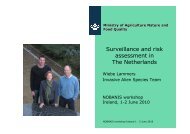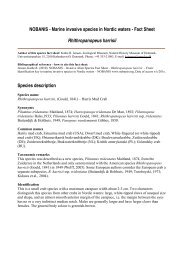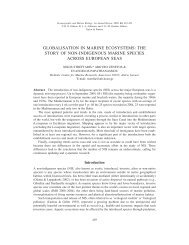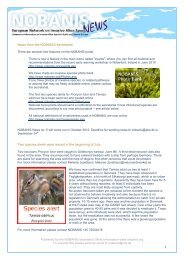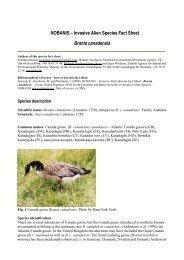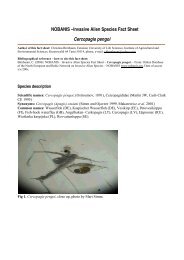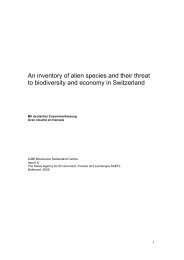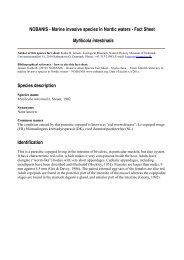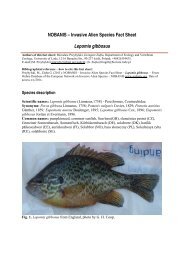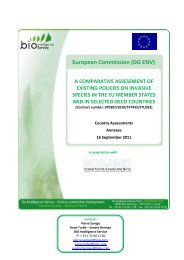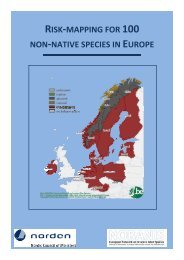Invasive Alien Species Fact Sheet – Mustela vison - NOBANIS
Invasive Alien Species Fact Sheet – Mustela vison - NOBANIS
Invasive Alien Species Fact Sheet – Mustela vison - NOBANIS
Create successful ePaper yourself
Turn your PDF publications into a flip-book with our unique Google optimized e-Paper software.
<strong>NOBANIS</strong> <strong>–</strong><strong>Invasive</strong> <strong>Alien</strong> <strong>Species</strong> <strong>Fact</strong> <strong>Sheet</strong><br />
<strong>Mustela</strong> <strong>vison</strong><br />
Author of this fact sheet: Christina Birnbaum, Estonian University of Life Sciences, Institute of Agricultural and<br />
Environmental Sciences, Kreutzwaldi 64 Tartu 51014, phone, E-mail: chbirnbaum@yahoo.com<br />
Bibliographical reference <strong>–</strong> how to cite this fact sheet:<br />
Birnbaum, C. (2006): <strong>NOBANIS</strong> <strong>–</strong> <strong>Invasive</strong> <strong>Alien</strong> <strong>Species</strong> <strong>Fact</strong> <strong>Sheet</strong> <strong>–</strong> <strong>Mustela</strong> <strong>vison</strong>. <strong>–</strong> From: Online Database of the<br />
North European and Baltic Network on <strong>Invasive</strong> <strong>Alien</strong> <strong>Species</strong> <strong>–</strong> <strong>NOBANIS</strong> www.nobanis.org, Date of access<br />
x/x/200x.<br />
<strong>Species</strong> description<br />
Scientific names: <strong>Mustela</strong> <strong>vison</strong>, (L.) Mustelidae.<br />
Synonyms: <strong>Mustela</strong> canadensis, <strong>Mustela</strong> rufa, Lutra <strong>vison</strong>, Vison lutreola<br />
Common names: American Mink, New World mink, Eastern mink (GB), Kanadischer Marder,<br />
Farmnerz, Nerz, Amerikanischer Mink, Amerikanischer Nerz (DE), Amerikansk mink (DK),<br />
Amerikansk flodilder (DK), Mink (EE), Minkki (FI), Minkur (IS), Amerikas ūdele (LV), Kanadinė<br />
audinė (LT), Norka amerykańska (PL), Американская норка (RU), Mink (SE).<br />
Fig.1. <strong>Mustela</strong> <strong>vison</strong>, photo by Remek Meel.
<strong>Species</strong> identification<br />
M. <strong>vison</strong> is a medium-sized carnivore. It has an elongated body with relatively short limbs, a typical<br />
feature of the weasel family (Mustelidae). Another characteristic feature of the family is its sexual<br />
dimorphism, i.e. males and females differ greatly in body characteristics. The males often attain a<br />
head and body length of 34 to 45 cm and a weight of 1500 g. In some localities animals are<br />
generally smaller, e.g. in Iceland the average weight of adult males has been observed to be only<br />
1200 g (Róbert A. Stefánsson, pers. comm.). The females are much smaller, having a head and body<br />
length of 31 to 38 cm and a weight of 400 to 800 g (cf. Stubbe 1975, 1988, 1993). The coat is dark<br />
brown, often with white markings in individual patterns on the ventral side. Various color mutations<br />
have been bred into the species, among them black, Aleutian, Palomino, pastel, pearl, various hues<br />
of gray, and even white (Stubbe 1993). The natural brown fur sometimes becomes bleached,<br />
especially on M. <strong>vison</strong> in coastal habitats.<br />
Although <strong>Mustela</strong> <strong>vison</strong> is from its appearance quite similar to <strong>Mustela</strong> lutreola, there is one feature<br />
that helps to differ between them: the upper and lower lip and the chin of <strong>Mustela</strong> lutreola is usually<br />
white while <strong>Mustela</strong> <strong>vison</strong> does not have this feature (Maran 2002).<br />
Native range<br />
The native range of M. <strong>vison</strong> is almost all of North-America (except in the north-east and southern<br />
parts).<br />
<strong>Alien</strong> distribution<br />
History of introduction and geographical spread<br />
M. <strong>vison</strong> was introduced for fur farming or released in many parts of Europe in the 1920's - 1930's<br />
but the modern intensive fur farming did not start until in the 1950's. Consequently, in addition to<br />
the animals deliberately released, M. <strong>vison</strong> escaping from farms initiated the feral populations. At<br />
present, <strong>Mustela</strong> <strong>vison</strong> is common in most European countries (Stubbe 1993).<br />
It was introduced to Latvia in 1944 and was first found on the River Gauja. In Latvia <strong>Mustela</strong> <strong>vison</strong><br />
also escaped from fur farms (Tauriņš 1982). In USSR <strong>Mustela</strong> <strong>vison</strong> was introduced for fur farming<br />
in 1928 (Doppelmair et al. 1966, Chylyat’ev 1975, Ivanov and Tymanov 1974, Michailov 1974,<br />
Popov 1964). In 1933-1977 about 21 300 individuals were introduced to the U.S.S.R. where they<br />
created a wild population and increased their range (Czesnokov 1989, Sinicyn 1990, Sokolskyi<br />
1990).<br />
Pathways of introduction<br />
M. <strong>vison</strong> repeatedly escaped from fur farms, as well as being deliberately introduced. Furthermore<br />
M. <strong>vison</strong> may be deliberately "liberated" by animal rights activists.<br />
<strong>Alien</strong> status in region<br />
In Estonia, M. <strong>vison</strong> is fully naturalized. In Denmark, Sweden, Norway and Finland M. <strong>vison</strong> is<br />
found almost everywhere (Kauhala 1996, Hammershøj and Asferg 2000). Besides Fennoscandia<br />
they are also found in the British Isles, Iceland, the Netherlands, France, Spain, other Baltic<br />
countries, Russia (Altay, Eastern Siberia, Tatarstan, Bashkiria) (Doppelmair et al. 1966), the Czech<br />
Republic and Italy (e.g. Lever 1985, Ozolinš and Pilāts 1995) (see table 1, next page, for details).<br />
2
Country Not Not Rare Local Common Very Not<br />
found established<br />
common known<br />
Denmark X<br />
Estonia X<br />
European part of Russia X<br />
Finland X<br />
Faroe Islands X<br />
Germany X<br />
Greenland X<br />
Iceland X<br />
Latvia X<br />
Lithuania X<br />
Norway X<br />
Poland X<br />
Sweden X<br />
Table 1. The frequency and establishment of <strong>Mustela</strong> <strong>vison</strong>, please refer also to the information<br />
provided for this species at www.nobanis.org/search.asp. Legend for this table: Not found <strong>–</strong>The<br />
species is not found in the country; Not established - The species has not formed self-reproducing<br />
populations (but is found as a casual or incidental species); Rare - Few sites where it is found in the<br />
country; Local - Locally abundant, many individuals in some areas of the country; Common -<br />
Many sites in the country; Very common - Many sites and many individuals; Not known <strong>–</strong> No<br />
information was available.<br />
Ecology<br />
Habitat description<br />
M. <strong>vison</strong> is mostly nocturnal and lives semi-aquatically along the coast and on the banks of rivers<br />
and lakes. It is commonly found on brook and river banks with dense vegetation, in (alder) forest<br />
marshes (Kirschey 2000), reed beds in sedimentation areas of lakes, and marshes furrowed by<br />
channels. Furthermore M. <strong>vison</strong> inhabits sea coastlines and archipelagos (Dunstone 1993, Kauhala<br />
1996). M. <strong>vison</strong> is adaptable to a variety of habitats, spanning from habitats in central Europe to<br />
harsh, pristine habitats of Iceland.<br />
In Denmark M. <strong>vison</strong> has furthermore widened its range to urban areas. There have been sightings<br />
of M. <strong>vison</strong> by the canals in the center of Copenhagen and an interview study showed that M. <strong>vison</strong><br />
had been seen within a year in 58 % of the 145 harbors investigated (Meier 2005). M. <strong>vison</strong> is<br />
furthermore an opportunist, so it has repeatedly been sighted near fowl and fish farms.<br />
Reproduction and life cycle<br />
The principal mating season is in March and April, according to various authors. The breeding<br />
biology of female <strong>Mustela</strong> <strong>vison</strong> includes superfecundation (multiple ova from a single ovulation)<br />
and superfoetation (multiple ovulations within one mating season) and delayed implantation<br />
(Enders 1952, Yamaguchi et al. 2004).<br />
The young are born in late April and early May, after a gestation period of about 50 days. The<br />
duration of the gestation period becomes shorter as temperatures increase. Stubbe (1988) reports<br />
litter sizes of 2 to 6 young in Eastern parts of Germany, but larger litter sizes (up to 12 young) are<br />
reported from Scandinavia. In Iceland, the average number of placental scars is 6, 8 (Skírnisson<br />
1992). The young become capable of hearing after 3 to 4 weeks and capable of seeing after 4 to 5<br />
3
weeks. The exclusive nursing period is 25 days. The males do not participate in rearing the young,<br />
who begin their first independent forays in July. The family breaks up in August and September.<br />
The turnover of wild populations of M. <strong>vison</strong> takes place in three-year periods; in captivity the<br />
animals may live for 10 years. Swedish investigations have shown that 84% of the animals in the<br />
wild live for only one year (Stubbe 1988). In western Poland daily survival rate in each season<br />
declined from 0,989 in autumn-winter to 0,977 in spring. Probability that <strong>Mustela</strong> <strong>vison</strong> would<br />
survive the whole season is only 0,1351 in autumn-winter and decreases to 0,1203 in spring. Many<br />
M. <strong>vison</strong> are killed on the roads, but their numbers are quickly replaced by an influx of new animals<br />
(Bartoszewicz and Zalewski 2003).<br />
According to Stubbe (1993), stable populations may establish themselves rapidly in vacant habitats<br />
lacking predators, and the population size then depends mostly on food availability and territorial<br />
behavior. Studies conducted in several northern European and North American habitats have shown<br />
that territories are 0.3 km (in Warta Mouth National Park <strong>–</strong> western Poland) to 6 km in length on the<br />
average. Animals of the same sex are not tolerated within the territory, and migrants lacking their<br />
own territory keep to the waterways. However they are able to cross areas considered hostile to M.<br />
<strong>vison</strong>, i.e. large fields, highways and railways (Meier 2005). In Warta Mouth National Park, where<br />
M. <strong>vison</strong> density is very high, territories of males overlap very often to a high degree <strong>–</strong> 44,2%<br />
during autumn-winter season and 55,0% in spring. Common space utilization can be caused by<br />
abundance of food supplies (Bartoszewicz 2003).<br />
Dispersal and spread<br />
The abandonment of agriculture in wetlands and the resulting emergence of reed belts and willow<br />
and alder shrubbery lead to an expansion of possible M. <strong>vison</strong> habitats (Schmidt 1985). Highlands<br />
with dense conifer forests e.g. the Fichtelgebirge and the Thuringian Forest, on the other hand,<br />
represent a barrier to the dispersal of M. <strong>vison</strong> (Kraft and van der Sant 1999).<br />
A cause for dispersal and spread of M. <strong>vison</strong> may also be "liberations" by animal protection activists<br />
(Skirnisson 1992, Kraft and van der Sant 1999), and insufficient precautionary measures on the<br />
farms - captures of 20 to 50 animals per year in the immediate vicinity of the farms were not<br />
unusual (Stubbe 1975).<br />
Impact<br />
Affected habitats and indigenous organisms<br />
M. <strong>vison</strong> affects indigenous animals by competition and is suspected of displacing its relative, the<br />
European mink, <strong>Mustela</strong> lutreola (which is threatened by extinction), and the European polecat,<br />
<strong>Mustela</strong> putorius (Schröpfer 1999). In Estonia the most serious effect of <strong>Mustela</strong> <strong>vison</strong> is its<br />
competition and intra-guild aggression with <strong>Mustela</strong> lutreola (European mink) (EU LIFE project,<br />
Kull 2005). In Denmark there are also concerns about the damage that M. <strong>vison</strong> may cause to<br />
polecats (<strong>Mustela</strong> putorius) and otters (Lutra lutra) (Hammershøj 2004). On the other hand, it has<br />
been suggested that the otter may be a stronger competitor for food and space, and thus may lead to<br />
local declines in the <strong>Mustela</strong> <strong>vison</strong> population (Jędrzejewska et al. 2001, Bonesi and Macdonald<br />
2004, Bonesi et al. 2004).<br />
Another effect of M. <strong>vison</strong> is as a predator. Its main food consists of fish, which may inflict serious<br />
damage on fish cultures (e.g. in Iceland, Sweden and England) (Skirnisson 1979), birds and small<br />
mammals, but it may also subsist on e.g. crustaceans, berries, amphibians and even carcasses<br />
(Dunstone and Birks 1987, Niemimaa and Pokki 1990, Jędrzejewska et al. 2001). The prey<br />
composition varies with the seasons (Skirnisson 1979) and also depends on the habitat (e.g. coast or<br />
inland waters).<br />
4
In its area of origin of M. <strong>vison</strong>, one of its principal prey species is the muskrat (Ondatra zibethica),<br />
Stubbe (1993) reports that this is also the case in Germany (cf. Schmidt 1985) and wetlands of<br />
western Poland ( Bartoszewicz and Zalewski 2003). Muskrat lodges appear to be an important<br />
feature of the M. <strong>vison</strong> habitat and are used for shelter (Stubbe 1993). In Poland the main winter diet<br />
of M. <strong>vison</strong> in Warta Mouth National Park are mammals, but after several years of exploitation of<br />
the muskrat population their number decreased and this species was replaced in the M. <strong>vison</strong> diet by<br />
voles Microtus sp. (Magdalena Bartoszewicz, pers. comm.). In the UK, populations of water voles<br />
(Arvicola terrestris) have declined, probably because of the interaction between habitat<br />
fragmentation and <strong>Mustela</strong> <strong>vison</strong> predation (e.g. Woodroffe et al. 1990, Rushton et al. 2000, Telfer<br />
et al. 2001).<br />
Many scientists across the breeding range of M. <strong>vison</strong> have expressed concerns about its effects on<br />
the survival and breeding success of native bird species. M. <strong>vison</strong> may further inflict serious damage<br />
on domestic fowl. In Estonia, M. <strong>vison</strong> represents a threat to water-birds, and attacks on bird nests<br />
are considered to be a problem (Kukk et al. 2001). Predation by M. <strong>vison</strong> has had devastating<br />
effects on some bird species, especially for colonial species and on islands in northern Europe and<br />
the UK (e.g. Hario et al. 1986, Andersson 1992, Kilpi 1995, Ferreras and Macdonald 1999, Craik<br />
1997, 2000, Opermanis et al. 2001, Clode and Macdonald 2002, Hario 2002). In Poland M. <strong>vison</strong><br />
has negatively affected the breeding success of water birds (Bartoszewicz 2003, Brzeziński 1998).<br />
Also in Denmark a number of incidents have been reported (by ornithologists) on M. <strong>vison</strong> having<br />
negative effects on local colonies of ground nesting birds (Meier 2005). Nordström et al. (2003)<br />
studied the effects of removing introduced <strong>Mustela</strong> <strong>vison</strong> on the number of birds breeding on small<br />
islands in the Baltic Sea. The breeding densities of some birds (Charadrius hiaticula, Stercorarius<br />
parasiticus, Anthus petrosus) increased markedly in the removal areas in comparison to the control<br />
areas. Two species (Alca torda, Cepphus grylle) already extinct in one of the removal areas,<br />
returned to breed in the area. Breeding densities of other birds like Larus marinus and Motacilla<br />
alba were unaffected. The authors conclude that it is possible to remove feral <strong>Mustela</strong> <strong>vison</strong> from<br />
large archipelagos with many small islands, and that M. <strong>vison</strong> removal increases the breeding<br />
densities of many bird species in this habitat.<br />
Another possible effect of M. <strong>vison</strong> on other species could be as a transmitter of infectious diseases<br />
(Macdonald 1996).<br />
Genetic effects<br />
Hybridisation between M. <strong>vison</strong> and native mustelids is possible (but not with European mink <strong>–</strong><br />
Janis Ozolins, pers. comm.). According to Ternovskii (1977) and Lariviére (1999) crossing between<br />
M. <strong>vison</strong> and M. lutreola may lead to resorption of hybrid embryos. However, hybridisation under<br />
natural conditions between mustelids has only been described on a few occasions (Rozhnow 1993;<br />
Da<strong>vison</strong> et al. 1999), none of which included M. <strong>vison</strong> and the problem is therefore considered<br />
hypothetical.<br />
Human health effects<br />
No reported effects on human health.<br />
Economic and social effects (positive/negative)<br />
In Estonia, the conditions for fur-farming are very strict resulting in relatively high costs for farm<br />
keepers. In the future it is planned to close all fur farms on the islands (Lilika Käis, pers. comm.).<br />
Intensive development of fur farms in western Poland is regarded to be dangerous for the native<br />
fauna because of M. <strong>vison</strong> escapes. Some owners of fishponds in Denmark and in Poland have also<br />
5
observed M. <strong>vison</strong> predation on their fish (Hammershøj 2004, Magdalena Bartoszewicz,<br />
pers.comm.). In Germany the costs of economic impacts caused by M. <strong>vison</strong> are estimated to be<br />
4,200,000 € (Reinhardt et al. 2003).<br />
Management approaches<br />
Prevention methods<br />
The Bern Convention on the Preservation of European Wild Plants and Animals and their Natural<br />
Habitats lists M. <strong>vison</strong> in Recommendation no. 77 among the species that should be eradicated. This<br />
has not been implemented yet. No decision has been reached at the national levels.<br />
According to Estonian List of <strong>Invasive</strong> <strong>Alien</strong> <strong>Species</strong> (Regulation of the Minister of Environment,<br />
No. 126 of October 7 th 2004) it is forbidden to bring M. <strong>vison</strong> into the country for artificial breeding<br />
or keeping. The paragraphs §49 and §57 of The Nature Protection Law describe the cases when<br />
particular prevention actions should take place regarding the problems of (invasive) species and<br />
their massive distribution. The plan is to make farming conditions very strict (in existing farms)<br />
where new species could be brought into the country only for breeding activities.<br />
A recent Danish government order (No. 610 of July 19 th 2002) places restrictions on M. <strong>vison</strong><br />
farmers to more effectively keep mink from escaping (Hammershøj 2004).<br />
Eradication, control and monitoring efforts<br />
In Europe there is some experience with species-specific control measures, but the results of these<br />
eradications campaigns have varied. In Iceland the feral populations of M. <strong>vison</strong> are still present all<br />
over the country, despite the new law programme (Hersteisson 1999). In Iceland, the first law which<br />
stated categorically that M. <strong>vison</strong> should be eradicated, was passed by the Althingi (parliament) in<br />
1949 (Hersteinsson 1999). With the new law, each local authority was made responsible for<br />
employing hunters to search for and kill mink within the boundaries of the community.<br />
Approximately seven thousand minks are killed in Iceland every year, but that does not seem to<br />
severely affect the total population size in the country, since the number of killed minks has risen<br />
steadily since the hunting began with a bounty for each killed mink in 1939. In 2006, the Icelandic<br />
government will start a project with the aim to eradicate mink in three chosen areas, which will<br />
indicate if a total eradication is possible or feasible. (Róbert A. Stefánsson, pers. comm.)<br />
In Britain an (unsuccessful) eradication campaign of the Ministry of Agriculture in a 5-year<br />
trapping programme cost £105,000 between 1965 and 1970 (Dunstone 1993). The cost of the<br />
campaign (excluding associated research costs) has been estimated, at 1990 costs, at £552,000<br />
(Baker 1990).<br />
According to the Danish government order LBK No. 818 of December 12 th 1987, escaped fur<br />
animals that are not recaptured within two months are considered game, and are thus included in<br />
government order BEK No. 801 of September 22 th 1999, which states that escaped fur animals that<br />
are considered game can be hunted/controlled all year, i.e. they are not protected in the breeding<br />
season (Hammershøj 2004). In the control campaign, carried out in Thy State Forest District (northwestern<br />
Jutland) by the Danish Forest and Nature Agency, 209 M. <strong>vison</strong> were killed during the<br />
three-year control scheme, but with unintentional deaths of non-target animals such as polecats,<br />
stoats, weasels, as well as a number of rodents and birds (unpubl. data). Therefore the adverse<br />
effects on the environment of control measures should be considered carefully (Usher 1986,<br />
Zavaleta et al. 2001). According to Hammershøj (2004) all eradication campaigns have been<br />
unsuccessful whenever they have been performed on national scale.<br />
6
In Poland M. <strong>vison</strong> is also considered a game animal. Hunting is allowed between August 1 st and<br />
March 31 st . In Warta Mouth National Park the number of M. <strong>vison</strong> is monitored since 1996 and<br />
protection plan for the national park includes controlling M. <strong>vison</strong> (Magdalena Bartoszewicz, pers.<br />
comm. 2005).<br />
M. <strong>vison</strong> can be hunted in all three Baltic countries without restrictions in terms of season. Selective<br />
trapping is also allowed. (Janis Ozolins, pers.comm.) In order to protect species in habitats and<br />
protected areas management plans and measures are provided to eradicate <strong>Mustela</strong> <strong>vison</strong> in Latvia<br />
(National Programme on Biological Diversity). The EU LIFE project (2001-2004) for recovery of<br />
European mink (<strong>Mustela</strong> lutreola) in Estonia included besides different other activities also a<br />
removal of the alien <strong>Mustela</strong> <strong>vison</strong> from the Saaremaa Island (Estonia). According to the final<br />
report of the project, M. <strong>vison</strong> does not have any viable and stable population in Saaremaa. Only a<br />
few individuals (mostly males) migrate from mainland to island Saaremaa, but are not able to start a<br />
viable population (EU LIFE project summary).<br />
In East Germany (former GDR, now the “new states”) it is permitted since 1984 to hunt or trap M.<br />
<strong>vison</strong> between 1 October and 31 March. Of the 29 animals found in northeastern Bavaria, 12 were<br />
captured with muskrat traps, and 5 in box traps (Kraft and van der Sant 1999). Lethal traps are not<br />
being used, to avoid possible threats to otters (van der Sant. pers. comm.; Schmidt 1985).<br />
In the south-western archipelago of Finland in the Baltic Sea, a <strong>Mustela</strong> <strong>vison</strong> removal project has<br />
been conducted since 1992 (enlarged in 1998) (the Metsähallitus and University of Turku). In two<br />
areas, consisting of ca 60 islands within 72 and 125 km 2 , <strong>Mustela</strong> <strong>vison</strong> has been removed during<br />
each autumn and spring. Responses in prey populations have been monitored in these two removal<br />
areas and compared with results from two control areas where <strong>Mustela</strong> <strong>vison</strong> populations have not<br />
been hunted. Some bird populations (e.g. velvet scoter (Melanitta fusca), tufted duck (Aythya<br />
fuligula), turnstone (Arenaria interpres), common gull (Larus canus) and arctic tern (Sterna<br />
paradisaea)) and populations of common frog (Rana temporaria) increased significantly after<br />
<strong>Mustela</strong> <strong>vison</strong> removal compared to control areas (Nordström et al. 2002, 2003, Ahola et al. 2006).<br />
Information and awareness<br />
The Estonian Ministry of Environment has published two booklets introducing invasive alien<br />
species of local importance (in 2001 and 2005). The purpose of those booklets is to make the<br />
general public aware of the problems going hand-in-hand with the spread of invasive species and to<br />
explain and show how the species look (through the pictures included in the booklets), and give<br />
some simple advice on how the spread of species could be controlled. During the EU LIFE project<br />
for the recovery of European mink on Saaremaa and Hiiumaa (Estonia) a public awareness<br />
campaign took place, which has created a highly positive public attitude towards the activities on<br />
the island (EU LIFE project activities).<br />
Knowledge and research<br />
The Danish Forest and Nature Agency has carried out a three-year M. <strong>vison</strong> control scheme in two<br />
areas, the Thy State Forest District in north-western Jutland and the State Forest District on<br />
Bornholm, a Danish island in the Baltic Sea. Animals were trapped in instant-kill traps. A PhD<br />
thesis (project) was based on these trial control schemes and gives a basic knowledge about the<br />
biology and population ecology of free-ranging M. <strong>vison</strong> in Denmark, including interactions<br />
between species and its surroundings (Hammershøj 2004). As a supplement to the research<br />
performed by Hammershøj, a master thesis study on M. <strong>vison</strong> in the Danish harbour environments<br />
and the harbours role as dispersal centres has been conducted at the Zoological Museum,<br />
Copenhagen. It was determined that M. <strong>vison</strong> is very common in the Danish harbours and it was<br />
demonstrated that three out of ten radio collared feral M. <strong>vison</strong>, dispersed from the harbour they<br />
were captured (Meier 2005).<br />
7
In Germany research concerning M. <strong>vison</strong> has taken place (Böhmer et al. 2001). The Bavarian State<br />
Ministry of Food, Agriculture and Forestry (Germany) has commissioned the Zoological State<br />
Museum of Munich to investigate the distribution, population size, spreading and possibilities for<br />
controlling M. <strong>vison</strong> in the region of Schwandorf (Kraft and van der Sant 1999). Essential<br />
information for the study is being provided by fish farmers, hunters, recreational fisherman and<br />
muskrat trappers (Ring and Preusch 2000). The authors conclude that it has now become impossible<br />
to exterminate M. <strong>vison</strong>. Based on his observations in the Löcknitz region, Kirschey (2000)<br />
recommends undertaking control measures against M. <strong>vison</strong> (Böhmer et al. 2001)<br />
The impact of the M. <strong>vison</strong> on native fauna was studied in eastern (Brzeziński 1998, Brzezński and<br />
Marzec 2003, Brzeziński and Żurowski 1992) and western Poland (Bartoszewicz and Zalewski<br />
2003). The biocenotical role of M. <strong>vison</strong>, its diet, space utilization and predator-prey relationships<br />
were studied on lakes and wetlands (Magdalena Bartoszewicz, pers. comm.). Furthermore within<br />
the confines of the Polish "National Strategy for the Conservation and Sustainable Use of<br />
Biological Diversity together with an Action Programme" - document approved by the Council of<br />
Ministers on February 25th 2003, it is recommended to study the impact of alien species on native<br />
species and ecosystems and also its social and economical effects. The result of such research<br />
should be “limiting of the number and expansion and controlling of the foreign species, especially<br />
those, which are the most dangerous for local biodiversity”. In the context of this strategy this is<br />
very important to study the ecology of the M. <strong>vison</strong> <strong>–</strong> one of the most recent invasive species in<br />
Poland.<br />
Recommendations or comments from experts and local communities<br />
Nationwide monitoring programs for M. <strong>vison</strong> are urgently recommended, focusing on the<br />
mechanisms by which M. <strong>vison</strong> displace native species, as well as the potential damage to fish<br />
farming (Böhmer et al. 2001). Without a common strategy based on detailed population biological<br />
knowledge, there may not be any major effects of controlling M. <strong>vison</strong> (Hammershøj 2004).<br />
Particular attention should be paid to the M. <strong>vison</strong> problem in countries with rich otter population<br />
(Baltic region). On one hand, Eurasian otter (Lutra lutra) is a considerable native competitor and to<br />
some extent even predator on M. <strong>vison</strong>, on the other hand M. <strong>vison</strong> may harm otter conservation<br />
policy because M. <strong>vison</strong> might be responsible for some of the predation, in particular on waterfowl<br />
that is normally attributed to L. Lutra. (Janis Ozolins, pers. comm.)<br />
References and other resources<br />
Contact persons<br />
Tiit Maran (EE) Foundation "Lutreola", Tallinn Zoo Paldiski mnt. 145, 13522, Tallinn, Estonia, Email:<br />
tiit.maran@lutreola.ee<br />
Janis Ozolins (LV) State Forest Service, Riga, 13 janvara Str. - 15, LV-1932, phone: 7212776, Email:<br />
janis.ozolins@vmd.gov.lv<br />
Magdalena Bartoszewicz (PL) Warta Mouth National Park, Chyrzyno 1, 69-113 Gorzyca, Poland,<br />
E-mail: przyroda@pnujsciewarty.gov.pl<br />
Róbert A. Stefánsson (IS) W-Iceland Institute of Natural History, Hafnargötu 3, IS-340<br />
Stykkishólmur, Iceland. Tel. (+354) 433 8121, E-mail: robert@nsv.is.<br />
8
Sidsel Bie Meier (DK) Zoological Museum University of Copenhagen Universitetsparken 15, 2100<br />
Copenhagen East, Denmark. E-mail: sbmeier@snm.ku.dk<br />
Mikael Nordström (FI) Archipelago Sea Biosphere Reserve, Regional Council of Subregion<br />
Åboland, PB 120, FIN-21601 Pargas, Finland. Tel. +358-400-445234, Fax: +358-2- 4585988, Email:<br />
mikael.nordstrom@parnet.fi<br />
Ingrid Bysveen (NO) Directorate for Nature Management, Tungasletta 2, N-7485 Trondheim,<br />
Norway, Phone: + 47 73 580 739, E-mail: ingrid.bysveen@dirnat.no<br />
Melanie Josefsson (SE) Swedish Environmental Protection Agency, SE 106 48 Stockholm,<br />
Sweden, tel: +46 18 67 31 48, fax: +46 18 67 31 56, E-mail: Melanie.Josefsson@snv.slu.se<br />
Maslyakov Valery (RU) Institute of Geography, Russian Academy of Sciences, Moskow,<br />
Staromonetnyi pereylok, 29, Russia. Tel.: 495 9590016. E-mail: Maslyakoff@mail.ru<br />
Links<br />
<strong>Fact</strong> sheet by Illinois Department of Natural Resources<br />
Polish <strong>Invasive</strong> <strong>Alien</strong> <strong>Species</strong> database<br />
Global <strong>Invasive</strong> <strong>Species</strong> Database - <strong>Fact</strong>sheet<br />
References<br />
Ahola, M., Nordström, M., Banks, P. B., Laanetu, N. and Korpimäki, E. 2006. <strong>Alien</strong> mink predation induces prolonged<br />
declines in archipelago amphibians. <strong>–</strong> Proceedings of the Royal Society of London B (in press).<br />
Andersson, Å. 1992. Development of waterbird populations in the Bullerö archipelago of Stockholm after colonization<br />
by Mink. - Ornis Svecica 2: 107-118. (In Swedish with English summary)<br />
Baker, S. 1990. Escaped exotic mammals in Britain. <strong>–</strong> Mammal Review 20: 75-96.<br />
Bartoszewicz, M. 2003. PhD thesis - Wpływ norki amerykańskiej (<strong>Mustela</strong> <strong>vison</strong>) na ptaki wodne i strategia ich<br />
ochrony w Parku Narodowym ”Ujście Warty”. Institute of Nature Conservation Polish Academy of Science. Poland.<br />
Bartoszewicz, M. and Zalewski, A. 2003. American mink (<strong>Mustela</strong> <strong>vison</strong>) diet and predation on waterfowl in the Słońsk<br />
Reserve, western Poland. Folia Zool. 52 (3): 225-238.<br />
Bonesi, L. and Macdonald, D. W. Impact of released Eurasian otters on a population of American mink: a test using an<br />
experimental approach. <strong>–</strong> Oikos 106: 9-18.<br />
Bonesi, L., Chanin, P. and Macdonald, D. W. 2004. Competition between Eurasian otter Lutra lutra and American mink<br />
<strong>Mustela</strong> <strong>vison</strong> probed by niche shift. <strong>–</strong> Oikos 106: 19-26.<br />
Brzeziński, M. and Żurowski W. 1992. Spring diet of the American mink (<strong>Mustela</strong> <strong>vison</strong>) in the Mazurian and Brodnica<br />
Lakelands in Poland. Acta theriologica 37 (1-2): 193-198.<br />
Brzeziński, M. 1998. PhD thesis <strong>–</strong> Biocenotyczna rola norki amerykańskiej <strong>Mustela</strong> <strong>vison</strong> w strefie pobrzeża<br />
jeziornego. University of Warsaw. Poland.<br />
Brzeziński, M. and Marzec, M. 2003. The origin, dispersal and distribution of the American mink (Mustal <strong>vison</strong>) in<br />
Poland. Acta theriologica 48 (4): 505-514.<br />
Böhmer, H. J., Heger, T. and Trepl, L. 2001. Fallstudien zu gebietsfremden Arten in Deutschland - Case studies on<br />
<strong>Alien</strong>s <strong>Species</strong> in Germany. <strong>–</strong> Texte des Umweltbundesamtes 2001 (13), 126pp.<br />
Chylyat’ev A.A. 1975. Amerikanskaya norka v Kirovskoy oblasty. Sbornik NTI (Ochota, pychnina, dich). VNIIOZ. V.<br />
49-50: 106-107.<br />
Clode, D. and Macdonald, D. W. 2002. <strong>Invasive</strong> predators and the conservation of island birds: the case of American<br />
mink <strong>Mustela</strong> <strong>vison</strong> and terns Sterna spp. in the Western Isles, Scotland. - Bird Study 49: 118-123.<br />
Craik, J. C. A. 1997. Long-term effects of North American Mink <strong>Mustela</strong> <strong>vison</strong> on seabirds in western Scotland. - Bird<br />
Study 44: 303-309.<br />
Craik, J. C. A. 2000. Breeding success of common gulls Larus canus in west Scotland II. Comparisons between<br />
colonies. - Atlantic Seabirds 2: 1-12.<br />
9
Czesnokov, N. I. 1989. Dzikije zywotnyje mieniajut adriesa. Mysl, Moskwa. Russia.<br />
Da<strong>vison</strong>, A., Birks, J. D. S., Griffiths, H. I., Kitchener, A. C., Biggins, D. and Butlin, R. K. 1999. Hybridization and the<br />
phylogenetic relationship between polecats and domestic ferrets in Britain. <strong>–</strong> Biological Conservation 87: 155-161<br />
Doppelmair G.G., Malchevskyi A.S., Novikov G.A., Falkenshtein B. Yu. 1966. Biologia lesnykh ptic i zverey. Vyshaya<br />
shkola, Moskow.<br />
Dunstone, N. 1993. The mink. <strong>–</strong> T and AD Poyser Ltd., London. England.<br />
Dunstone, N. and Birks, J. D. S. 1987. The feeding ecology of mink (<strong>Mustela</strong> <strong>vison</strong>) in a coastal habitat. - Journal of<br />
Zoology 212: 69-83.<br />
Enders, R.K. (1952) Reproduction in the mink (<strong>Mustela</strong> <strong>vison</strong>). <strong>–</strong> Proc. Am. Phil. Soc. 96: 691-755.<br />
Ferreras, P. and Macdonald, D. W. 1999. The impact of American mink <strong>Mustela</strong> <strong>vison</strong> on water birds in the upper<br />
Thames. - Journal of Applied Ecology 36: 701-708.<br />
EU LIFE project LIFE2000NAT/EE/7081 entitled “Recovery of <strong>Mustela</strong> lutreola in Estonia: captive and island<br />
populations”. Covering period: 1. September 2001 <strong>–</strong> 30. November 2004. Report compiled by Tiit Maran.<br />
Foundation “LUTREOLA”. Paldiski road 145, Tallinn 13522. Estonia. (Web version of project, final report of the<br />
project and short summery of the project; [English] )<br />
Hammershøj, M. and Asferg, T. 2000. Mink and Polecats in Denmark: status, control and damage to poultry. Mammal<br />
review, 30: 228.<br />
Hammershøj, M. 2004. PhD thesis <strong>–</strong> Population ecology of free-ranging American mink <strong>Mustela</strong> <strong>vison</strong> in Denmark.<br />
National Environment Research Institute. Ministry of Environment. Denmark (web-version).<br />
Hario, M. 2002. Mink (<strong>Mustela</strong> <strong>vison</strong>) predation on black guillemots at Söderskär in 1994-1999. - Suomen Riista 48:<br />
18-26. (In Finnish with English summary)<br />
Hario, M., Komu, R., Muuronen, P. and Selin, K. 1986. Population trends among archipelago birds in Söderskär bird<br />
sanctuary. - Suomen Riista 33: 79-90. (In Finnish with English summary)<br />
Hersteinsson, P. 1999. Methods to eradicate the American mink (<strong>Mustela</strong> <strong>vison</strong>) in Iceland. In: Workshop on the control<br />
and eradication of non-native terrestrial vertebrates, Sliema, Malta, 3-5 June 1999. <strong>–</strong> Council of Europe, Strasbourg,<br />
Report no. T-PVS (99) 26: 17-21.<br />
Ivanov P.D. and Tymanov I.L. 1974. Amerikanskaya norka v Leningradskoy oblasty. Sbornik NTI (Ochota, pychnina,<br />
dich). VNIIOZ. V.42: 3-9.<br />
Jędrzejewska, B., Sidorovich, V. E., Pikulik, M. M. and Jędrzejewski, W. 2001. Feeding habits of the otter and the<br />
American mink (<strong>Mustela</strong> <strong>vison</strong>) in Bialowieza Primeval forest (Poland) compared to other Eurasian populations. -<br />
Ecography 24: 165-180.<br />
Kauhala, K. 1996. Distribution history of the American mink (<strong>Mustela</strong> <strong>vison</strong>) in Finland with special reference to the<br />
trends in otter (Lutra lutra) populations. Ann. Zool. Fennici 33: 283.<br />
Kilpi, M. 1995. Breeding success, predation and local dynamics of colonial common gulls Larus canus. - Annales<br />
Zoologici Fennici 32: 175-182.<br />
Kirschey, T. 2000. Das „Neozoen-Problem“ aus Sicht des herpetologischen Artenschutzes. <strong>–</strong> In: NABU (ed.), Was<br />
macht der Halsbandsittich in der Thujahecke? Zur Problematik von Neophyten und Neozoen und ihrer Bedeutung<br />
für den Erhalt der biologischen Vielfalt, S. 65-72.<br />
Kraft, R. and D. van der Sant. 1999. Bestandssituation und Ausbreitungstendenz des Amerikanischen Nerzes (<strong>Mustela</strong><br />
<strong>vison</strong> Schreber, 1777) in Nordostbayern. <strong>–</strong> Säugetierkd. Inf. 4 (23): 447-452.<br />
Kukk, T., Kull, T., Lilleleht, V., Ojaveer, H. 2001. <strong>Alien</strong> species in estonia.[Võõrliigid Eestis]. Keskkonnaministeerium.<br />
Tallinn. Estonia.<br />
Kull, T., 2005. <strong>Invasive</strong> alien species in Estonia. [Invasiivsed võõrliigid Eestis]. Keskkonnaministeerium. Tallinn.<br />
Estonia.<br />
Lariviére, S. 1999. <strong>Mustela</strong> <strong>vison</strong>, Mammalian <strong>Species</strong>. no. 608 pp.1-9, Pub. American Society of Mammalogists.<br />
Lever, C. 1985. Naturalized mammals of the world. Longman Group Ltd., Essex.<br />
LUA - Landesumweltamt Brandenburg (1999): Artenschutzprogramm Elbebiber und Fischotter. - Potsdam (LUA<br />
Brandenburg), 51 S.<br />
Macdonald, D. W. 1996. Dangerous liaisons and disease. <strong>–</strong> Nature 379: 400-401.<br />
Maran, T. 2002. Mammals of Europe. [Euroopa imetajad]. Eesti Entsüklopeediakirjastus<br />
Meier, S. B. 2005. Master thesis <strong>–</strong> American Mink <strong>Mustela</strong> <strong>vison</strong> in the Danish harbour environments and the harbours<br />
role as dispersal centres. Zoological Museum University of Copenhagen.<br />
Michailov V.B. 1974. Akklematizaciya amerikanskoy norki v gorno-lesnoi zone Chelyabinskoi oblasty. Sbornik NTI<br />
(Ochota, pychnina, dich). VNIIOZ. V.43: 3-8.<br />
Niemimaa, J. and Pokki, J. 1990. Food habits of the mink (<strong>Mustela</strong> <strong>vison</strong>) in the outer archipelago of the Gulf of<br />
Finland. - Suomen Riista 36: 18-30. (In Finnish with English summary)<br />
10
Nordström, M., Högmander, J., Nummelin, J., Laine, J., Laanetu, N. and Korpimäki, E. 2002 Variable responses of<br />
waterfowl breeding populations to long term removal of introduced American mink (<strong>Mustela</strong> <strong>vison</strong>). - Ecography<br />
25: 385-394.<br />
Nordström, M., Högmander, J., Laine, J., Nummelin, J., Laanetu, N. and Korpimäki, E. 2003 Effects of feral mink<br />
(<strong>Mustela</strong> <strong>vison</strong>) removal on seabirds, waders and passerines on small islands of the Baltic Sea. - Biological<br />
Conservation 109: 359-368.<br />
Opermanis, O., Mednis, A. and Bauga I. 2001. Duck nests and predators: interaction, specialisation and possible<br />
management. - Wildlife Biology 7: 87-96.<br />
Ozolinš, J. and Pilāts, V. 1995. Distribution and status of small and medium-sized carnivores in Latvia. Ann. Zool.<br />
Fennici 32:21-29.<br />
Popov V.A. 1964. Rezultaty akklematizacii amerikanskoy norki (<strong>Mustela</strong> <strong>vison</strong> Br.) v SSSR. Prirodnye resyrsy<br />
Volgsko-Kamskogo kraya (jyvotnyi mir). Moscow, Nayka: 5-15.<br />
Reinhardt, F., Herle, M., Bastiansen, F., Streit, B. 2003. Economic Impact of the Spread of <strong>Alien</strong> <strong>Species</strong> in Germany.<br />
pp 183.<br />
Rushton, S. P., Barreto, G. W., Cormack, R. M., Macdonald, D. W. and Fuller, R. 2000. Modelling the effects of mink<br />
(<strong>Mustela</strong> <strong>vison</strong>) and habitat fragmentation on the water vole. - Journal of Applied Ecology 37: 475-490.<br />
Ring, Th. and Preusch, E. 2000. Minkvorkommen 1999 nach Erhebungsbögen des Fishereiverbandes Oberpfalz. <strong>–</strong><br />
Unveröff. Studie, Regierung der Oberpfalz. Regensburg.<br />
Rozhnov, V.V. 1993. Extinction of the European mink: ecological catastrophe or a natural process? <strong>–</strong> Lutreola 1: 10-16.<br />
Schmidt, A. 1985. Zum Vorkommen des Minks <strong>Mustela</strong> <strong>vison</strong> (Schreber 1777) im Süden des Bezirkes Frankfurt/Oder.<br />
<strong>–</strong> Säugetierkd. Inf. 2 (9): 292-297.<br />
Schröpfer, R. 1999. Gewinner Mink <strong>–</strong> Verlierer Nerz. Nischenkämpfe. <strong>–</strong> Wild und Hund 102 (4): 32-34.<br />
Sinicyn A.A. 1990. Rezultaty akklematizacii amerikanskoy norki v ravninnoy chasti Zapadnoi Sibiri. Intesifikaciya<br />
vosproizvodstva resyrsov ochotnychiikh jivotnykh. Kirov: 170-180.<br />
Skirnisson, K. 1979. Food habits of Mink (<strong>Mustela</strong> <strong>vison</strong> Schreber) in Grindavik, south west Iceland. <strong>–</strong><br />
Natturufrädingurinn 49: 194-203.<br />
Skirnisson, K. 1992. Die falsch verstandene Freiheit. <strong>–</strong> Fauna 4/92: 12-14.<br />
Skirnisson, K. 1992. Zur Biologie der Isländischen Minkpopulation. Semiaquatic Mammals. (Herausg. R. Schröpfer, M.<br />
Stubbe and D. Heidecke). Wiss. Beiträge Univ. Halle 1992: 277-295.<br />
Sokolskyi S.M. 1990. <strong>Mustela</strong> (Lutreola) <strong>vison</strong> Schreber, 1777 - Amerikanskaya norka. Mlekopitayuchie,<br />
Kitoobraznye, Parnopalye (Fauna evropeyskogo Severo-Vostoka Rossii. Mlekopitayuchie. Т.II. ch. 2. Spb.,<br />
Nayka:159-169.<br />
Stubbe, M. 1975. Der Amerikanische Nerz <strong>Mustela</strong> <strong>vison</strong> (Schreber, 1777) in der DDR. <strong>–</strong> Beiträge zur Jagd- und<br />
Wildforschung 9: 364-386.<br />
Stubbe, M. 1988. Die expansive Arealerweiterung des Minks <strong>Mustela</strong> <strong>vison</strong> (Schreber, 1777) in der DDR in den Jahren<br />
1975-1984. <strong>–</strong> Beiträge zur Jagd- und Wildforschung 15: 75-90.<br />
Stubbe, M. 1993. <strong>Mustela</strong> <strong>vison</strong> <strong>–</strong> Mink. <strong>–</strong> In: J. Niethammer, F. Krapp (ed.), Handbuch der Säugetiere Europas. Band<br />
5: Raubsäuger <strong>–</strong> Carnivora (Fissipedia). Wiesbaden.<br />
Tauriņš, E. 1982. Latvijas zīdītājdzīvnieki. Zvaigzne, Rīga, 256 pp.<br />
Telfer, S., Holt, A., Donaldson, R. and Lambin, X. 2001. Metapopulation process and persistence in remnant water vole<br />
populations. - Oikos 95: 31-42.<br />
Ternovskii, D.V. 1977. The biology of the Mustelidae. Akademii Nauk. Novosibirisk, 280 pp.<br />
Usher, M.B. 1986. Invasibility and wildlife conservation: invasive species on nature reserves. <strong>–</strong> Philosophical<br />
Transactions of the royal Society of London, B 314: 695-710.<br />
Woodroffe, G., Lawton, J. and Davidson, W. 1990. The impact of feral mink <strong>Mustela</strong> <strong>vison</strong> on water voles Arvicola<br />
terrestris in the North Yorkshire Moors National Park. - Biological Conservation 51: 49-62.<br />
Yamaguchi, N., Sarno, R.J., Johnson, W.E., O’Brien, S.J. & Macdonald, D.W. (2004) Multiple paternity and<br />
reproductive tactics of free-ranging American minks, <strong>Mustela</strong> <strong>vison</strong>. <strong>–</strong> Journal of Mammalogy 85: 432-439.<br />
Zavaleta, E. S., Hobbs, R. J. and Mooney, H. A. 2001. Viewing invasive species removal in a whole-ecosystem context.<br />
<strong>–</strong> TREE 16: 454-459.<br />
Date of creation/modification of this species fact sheet <strong>–</strong> 07-05-2007.<br />
11



